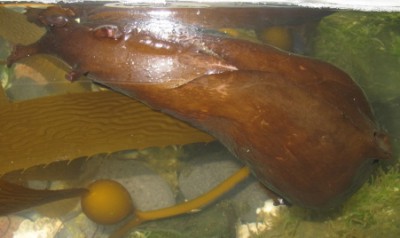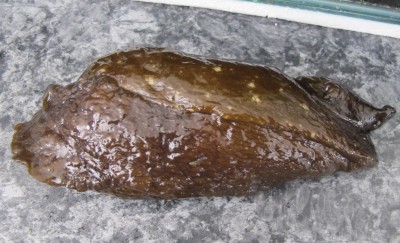Sea hares from Tristan da Cunha
June 1, 2010
From: Sue Scott

Hello Bill,
More seaslugs from Tristan da Cunha in the South Atlantic - sea hares have just been found by islanders, in shallow rock pools. The animals were up to 160 mm long, and exuded ink. The islanders did not report them swimming, but I will ask. Approx lat/long for the position is 37°05'17.62 S, 12°20'14.90 W. Water temperatures on Tristan vary between 14-20 degrees C.
After trawling through your fact files on sea hare species, the closest I can get is Aplysia brasiliana/ A. fasciata. Pink tinges are visible on the parapodia in one photo. One specimen is plain brown, another has a few cream-coloured spots. The dorsal flaps seem well separated, and roll into a small hole far back near the posterior.
Can you confirm this id, bearing in mind that Tristan is very remote from any other shallow water areas, has many endemics, and describing new species from there is not unusual. This is the first time sea hares have been reported from Tristan to my knowledge - we didn't find any in 5 years of survey work there, although if the populations are very local (i.e.confined to a small stretch of shore (which seems unlikely given their larval dispersal) we might have missed them.Many of Tristan's colonisers by natural means have some from South America and a good proportion also from South Africa, so it would be interesting to know which side of the Atlantic the Tristan specimens originated. However introductions have also occurred through human vectors, most spectacularly when an oil production platform (originating in Brazil) stranded on Tristan in 2006. When we examined the rig we found a huge number of non-native species encrusting the legs, and even some non-native fish that had come across with the rig (and are now well established on Tristan), but no sea hares, and I think it unlikely that they would have survived the stormy crossing.
If there is anyone out there interested in doing genetic work on them, perhaps as part of the A. fasciata/brasiliana debate, I can get a specimen preserved in alcohol for sequencing.
Locality: Flat Rocks, Runaway Beach, Intertidal, Tristan da Cunha, South Atlantic Ocean, May 2010, Intertidal rock pools in fairly extensive rock flats (lava flows), extremely exposed to waves at times. Length: 160 mm. Photographer: Kirsty Green.
Incidentally, a specimen of Anisodoris/Doris fontainei was also found in the rock pools, but thanks to previous correspondence on the seaslug form, was identified immediately!
Best regards,
Sue
suescott153@btinternet.com
Scott, S., 2010 (Jun 1) Sea hares from Tristan da Cunha. [Message in] Sea Slug Forum. Australian Museum, Sydney. Available from http://www.seaslugforum.net/find/23706
Dear Sue,
Looking at these photos, I am pretty sure this is one of the species in which the parapodia join posteriorly, the 'join' forming quite a high wall partially enclosing the mantle cavity. Yu will see in the lower photo how the exhalent siphon seems to be poking out posteriorly, over a wall. These species dont really swim, and more importantly don't produce a purple ink - although they do produce a viscous white ink. If you could check with the collectors about the colour of the ink they observed it would be useful.
There is the quite feasible possibility that you have more than one species of Sea Hare occurring together - and inker and a non-inker.
Ignoring the inking, my feeling is that this is Aplysia juliana which is widespread throughout the world. Interestingly Eales in her 1960 revision of the world species described a new species of Aplysia from two preserved animals from Tristan da Cunha. She named in Aplysia dura. From her anatomical description it certainly appears to be A. juliana, and her description of the mantle cavity anatomy certainly suggests it does not produce purple ink.
If the local residents do say they saw purple or red ink then my first suggestion is to check if there is more than one species present. You will see from your photos that when the animals are 'sitting' the posterior part off the foot is enlarged and rounded into a sucker. This is very characteristic of A. juliana and others of this non inking group. Inking species usually have the parapodia separate posteriorly and have a more tapering 'tail'.
- Eales, N. B. (1960). Revision of the world species of Aplysia (Gastropoda, Opisthobranchia). Bulletin of the British Museum (Natural History), Zoology, 5(10): 267-404.
Best wishes,
Bill Rudman
Related messages
-
Aplysia juliana? from Reunion Island
From: Philibert Bidgrain, January 31, 2007 -
Re: Aplysia juliana in my aquarium
From: Michelle Yerman, May 25, 2006 -
Aplysia juliana in my aquarium
From: Michelle Yerman, May 19, 2006 -
Aplysia juliana eaten by Flatworm
From: Lisa Kirkendale, April 10, 2006 -
Re: Sea Hares laying noodle shaped things in tank
From: Marcus van Riet, December 17, 2005 -
Sea Hares laying noodle shaped things in tank
From: Marcus van Riet, December 6, 2005 -
Aplysia juliana? in Kiama rock pools, NSW
From: Francis Hawkshaw, August 9, 2005 -
Aplysia juliana being eaten by crab
From: Dong Bum Koh, June 7, 2005 -
Aplysia juliana laying eggs
From: Dong Bum Koh, May 25, 2005 -
Aplysia juliana - breeding in Tasmania
From: Melanie Godfrey-Smith, November 16, 2003 -
Aplysia juliana - breeding in NZ
From: Paul Furneaux, August 16, 2003 -
Aplysia juliana from New Zealand
From: Paul Furneaux, June 30, 2003 -
Sea hares, mating pair - from Sydney
From: Iain Whyte, November 30, 2002 -
Aplysia juliana from Korea
From: Ronald Noseworthy, June 19, 2002 -
Re: Aplysia from Taiwan
From: Tony Wright, April 16, 2001 -
Aplysia from Taiwan
From: Tony Wright, April 14, 2001 -
Sea Slug feeding and babies
From: Andrew McDonald, February 16, 2000
